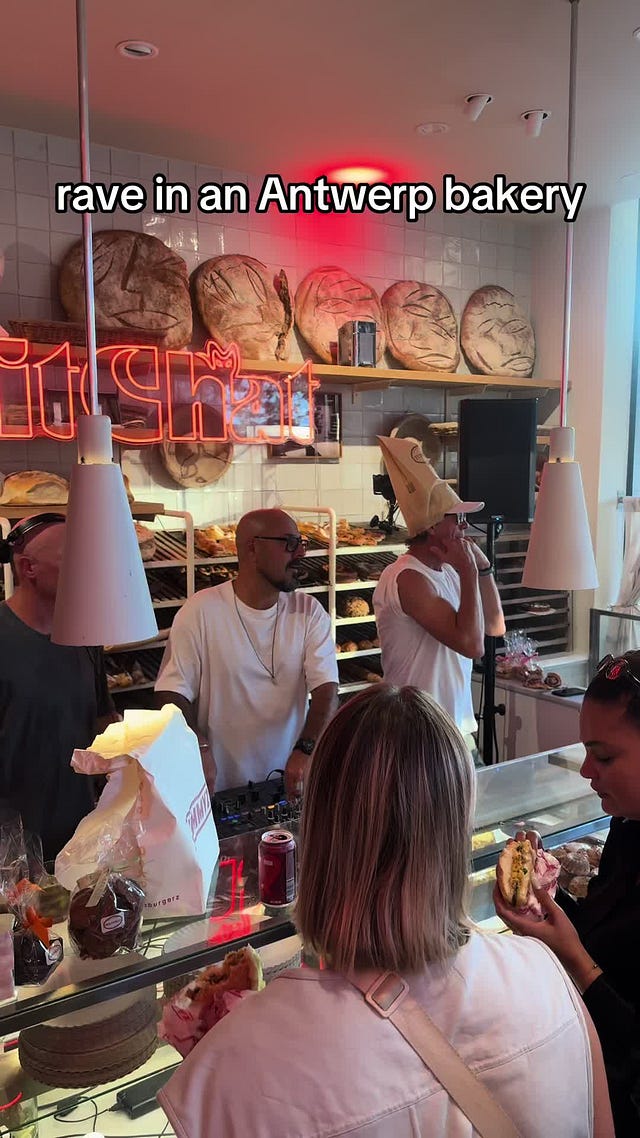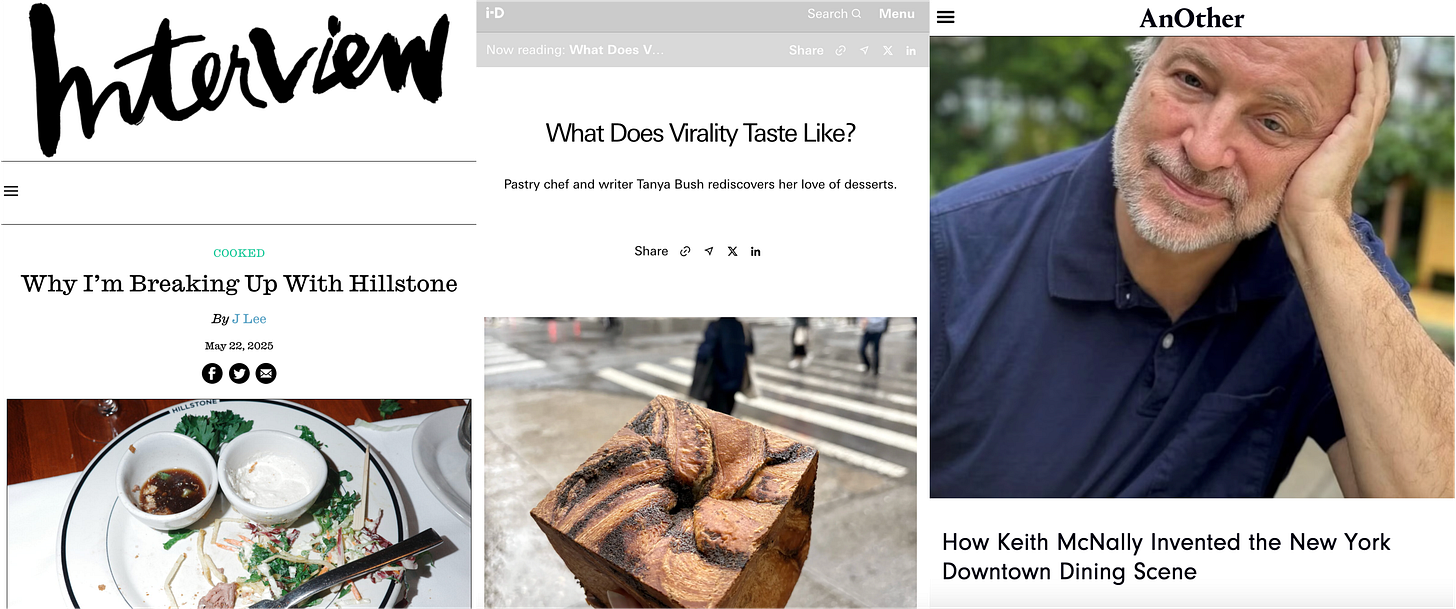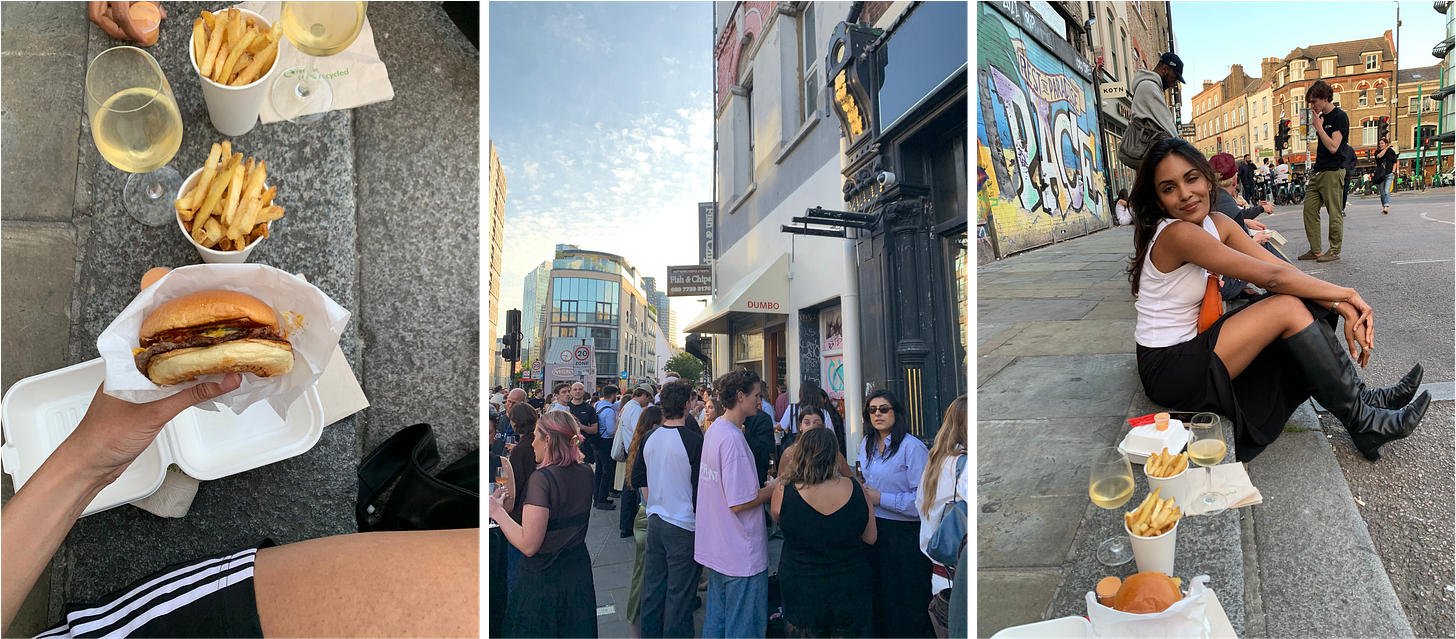Soft clubbing, food culture & the stan-ification of media
“Traditional clubs down, soft clubs in”
Hello.
I’m back. It’s fun to be here with you again so soon.
The energy of this week has been a lot softer than last’s. Spacious mornings, big work days, rested nervous systems, and Ashtanga practices. It’s been nice.
I keep a note in my Notes app with topics I come across each week. Some are small observations, like “cool girls are offline.” Others are sparked by something I’ve read, like “the colour of money.” Then there are themes I want to explore more deeply – like Gen Z economic nihilism, the return of God, or anhedonia.
Often, I’ll pick one or two topics I’m most interested in exploring that week. I definitely have recency bias, which means there are always a few ideas that have been sitting on the list for months… untouched, unexplored.
But not this week.
This week, I’m diving into the topics I’ve been meaning to write about for a while. Plus, one I came across more recently, added in for good measure.
So, let’s get into it, shall we?
Agenda for today’s letter:
The rise of the soft club
How dining became fashion media’s new favourite beat
The stan-ification of media
The rise of the soft club
Traditional clubs down, soft clubs up

An interesting phenomenon has been happening in the world of going out and socialising.
It’s been long documented that the club is in decline. I first heard about this shift many moons ago (at some point near the beginning of 2024) via a Nymphet Alumni podcast. Gen Z are going out and drinking less. Traditional nightlife, in cities across the world, is in sharp decline. Which is why, when I came across Yusuf Ntahilaja’s Substack a few months ago, I was instantly intrigued.
Titled 2025: The Year of Soft Clubbing, Yusuf expertly identifies a new trend gaining traction across cities worldwide: the rise of the “soft club”. Essentially any space (a bakery, a bagel shop, a train) that’s temporarily transformed into a pop-up club, complete with DJ decks and a crowd of people dancing.
As Yusuf writes:
Soft clubbing speaks to the shift in our social needs in a post-pandemic world, the very same needs that have led to a rise in run clubs and hobby clubs such as chess and bowling. Previously the club was an adequate provider of your weekly dose of social interaction, a space to dance, socialise and, for many, get intoxicated too. However, for a generation that is drinking less and desiring more socially, the club is no longer the primary medium for our social needs.
The concept – and the language around ‘soft clubbing’ – is, in my humble opinion, brilliant. It captures how we’re connecting and socialising today. Many Gen Zs don’t want to be out until the early hours. And those who do, can still fall in love the novelty and intimacy of the soft club. Because who doesn’t want to rave in a bakery? Or dance in an old hair salon?
No matter your appetite, one thing is clear: fun begets fun. The exclusive, pop-up nature of transforming seemingly benign spaces into sites of joy, music, and play creates something fleeting and electric; a feeling that can’t be replicated. In a cultural moment obsessed with IYKYK energy, the soft club is its perfect IRL expression.
A few weeks ago, the soft club hit the mainstream, with Samantha Leal writing a piece for The Cut titled Soft Clubbing Is the New Going Out.
I think we’ll see more of where this came from.
The Food-Fashion Merge
How dining became fashion media’s new favourite beat
Food has always had a place in the zeitgeist. But lately, there’s been a noticeable shift in how fashion media is engaging with food - particularly restaurant and hospitality culture.
As someone with previous ties to hospitality and a self-proclaimed food girl, I’ve always believed that restaurants, bars, and venues are where some of the best culture lives and breathes. They say so much about what we desire and aspire to. I’ve long been obsessed with how people dine, where they go, and what it reveals about them.
It’s why I love media that treats restaurants with insider reverence. Emily Sundberg’s FeedMe does this brilliantly. But until recently, this kind of food coverage felt niche – rarely overlapping with fashion, beauty, or lifestyle media in any consistent way.
That’s what’s changing.
Interview Magazine just launched a food column, Cooked, helmed by FeedMe’s semi-anonymous restaurant critic J. Lee. i-D commissioned a viral pastry chef to talk desserts. And British Vogue continues to give food prime real estate in its editorial calendar. Oh, and let’s not forget everyone’s obsession with Keith McNally right now. Taken together, the message is clear: food’s rise in fashion media is impossible to ignore.
Even on the ground, the shift is obvious. At Dumbo’s opening in Shoreditch a few weeks ago, the crowd felt more Fashion Week than food launch. I was obsessed with it.
All of this reflects a broader shift. As luxury brands expand into hotels, cafés and restaurants, fashion media isn’t just observing. It’s following suit.
The Stan-ification of Media
Where journalism ends and PR cosplay begins
When I came across Tobias Hess’ viral Substack, Why Are All Pop Star Interviews Like This Now?, I knew I had to talk about it. Because he’s right: something strange is happening in the world of celebrity media. Podcasters, hosts, even seasoned journalists are acting less like critics or interviewers, and more like stans.
To be fair, this has been brewing for a while. But it feels like we’ve now reached a tipping point. The timing of Hess’s piece going viral is telling, especially alongside Jameela Jamil’s recent Substack, where she shared that she no longer wants to be interviewed by female journalists.
Keep reading with a 7-day free trial
Subscribe to Step Into My Office to keep reading this post and get 7 days of free access to the full post archives.








